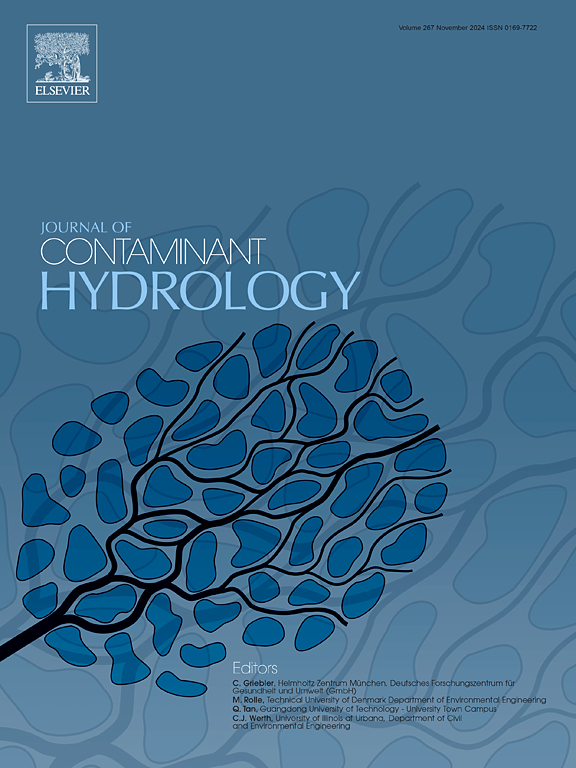Modelling occurrence and environmental risk of azithromycin in an intermittent river: Applying hydrological and water quality models
IF 3.5
3区 环境科学与生态学
Q2 ENVIRONMENTAL SCIENCES
引用次数: 0
Abstract
Antibiotics are emerging pollutants that may negatively affect river ecosystems. The present paper aims to define a modelling approach for assessing the fate of pharmaceuticals and the ecotoxicological risk in surface waters in intermittent rivers. A hydrological model (Soil and Water Assessment Tool) and a water quality model (Geography-referenced Regional Exposure Assessment Tool for European Rivers) were used in a modelling cascade application in the Canale d'Aiedda basin (S-E, Italy). Measurements of streamflow and azithromycin (AZ) concentrations were used for calibrating the models. Predicted Environmental Concentrations (PEC) of AZ in surface waters and the ecotoxicological risk were estimated. The highest AZ concentrations in the effluent of wastewater treatment plants (2553 ng L−1) and in surface waters were recorded in March 2021. The monitoring and modelling results indicated seasonal changes in AZ concentrations in surface waters: in August, the PEC was one order of magnitude lower than in March. The river reaches downstream of the inlets from the WWTPs presented the highest PEC of AZ, whereas a reduction of PEC was simulated moving downstream of the inlets. The results of the ecotoxicological risk assessment showed that in March most of the river network presented a PEC of AZ higher than the Predicted No-Effect Concentration (PNEC). Coupling the two models has proven to be an effective approach to address the complex interaction between hydrology and water quality in intermittent rivers, suitable for identifying the occurrence and environmental risk of emerging pollutants, fundamental steps for their management.

模拟阿奇霉素在断续河流中的发生和环境风险:应用水文和水质模型
抗生素是可能对河流生态系统产生负面影响的新兴污染物。本文旨在定义一种建模方法,用于评估间歇河流地表水中药物的命运和生态毒理学风险。一个水文模型(土壤和水评估工具)和一个水质模型(欧洲河流地理参考区域暴露评估工具)在Canale d'Aiedda流域(意大利南、东)的级联建模应用中使用。测量水流和阿奇霉素(AZ)浓度用于校准模型。估算了地表水中AZ的预测环境浓度(PEC)和生态毒理学风险。在2021年3月,废水处理厂的出水和地表水中的阿斯利康浓度最高(2553纳克L - 1)。监测和模拟结果显示了地表水中AZ浓度的季节性变化:8月份,PEC比3月份低一个数量级。在污水处理厂入口下游,模拟出了最高的AZ PEC,而在入口下游,模拟出了PEC的降低。生态毒理学风险评价结果显示,3月份大部分河网的PEC均高于预测无影响浓度(PNEC)。将这两个模型结合起来已被证明是解决间歇性河流中水文和水质之间复杂相互作用的有效方法,适用于识别新出现污染物的发生和环境风险,这是其管理的基本步骤。
本文章由计算机程序翻译,如有差异,请以英文原文为准。
求助全文
约1分钟内获得全文
求助全文
来源期刊

Journal of contaminant hydrology
环境科学-地球科学综合
CiteScore
6.80
自引率
2.80%
发文量
129
审稿时长
68 days
期刊介绍:
The Journal of Contaminant Hydrology is an international journal publishing scientific articles pertaining to the contamination of subsurface water resources. Emphasis is placed on investigations of the physical, chemical, and biological processes influencing the behavior and fate of organic and inorganic contaminants in the unsaturated (vadose) and saturated (groundwater) zones, as well as at groundwater-surface water interfaces. The ecological impacts of contaminants transported both from and to aquifers are of interest. Articles on contamination of surface water only, without a link to groundwater, are out of the scope. Broad latitude is allowed in identifying contaminants of interest, and include legacy and emerging pollutants, nutrients, nanoparticles, pathogenic microorganisms (e.g., bacteria, viruses, protozoa), microplastics, and various constituents associated with energy production (e.g., methane, carbon dioxide, hydrogen sulfide).
The journal''s scope embraces a wide range of topics including: experimental investigations of contaminant sorption, diffusion, transformation, volatilization and transport in the surface and subsurface; characterization of soil and aquifer properties only as they influence contaminant behavior; development and testing of mathematical models of contaminant behaviour; innovative techniques for restoration of contaminated sites; development of new tools or techniques for monitoring the extent of soil and groundwater contamination; transformation of contaminants in the hyporheic zone; effects of contaminants traversing the hyporheic zone on surface water and groundwater ecosystems; subsurface carbon sequestration and/or turnover; and migration of fluids associated with energy production into groundwater.
 求助内容:
求助内容: 应助结果提醒方式:
应助结果提醒方式:


